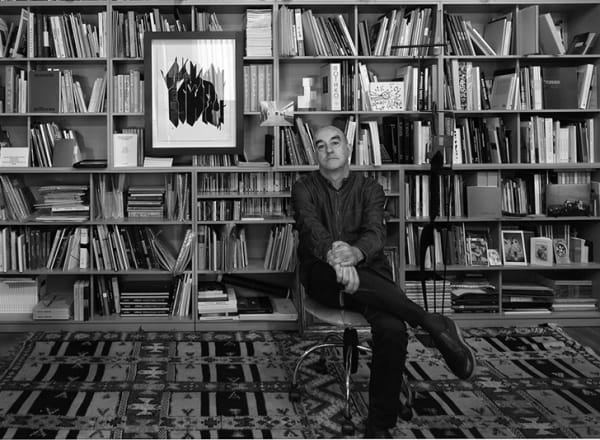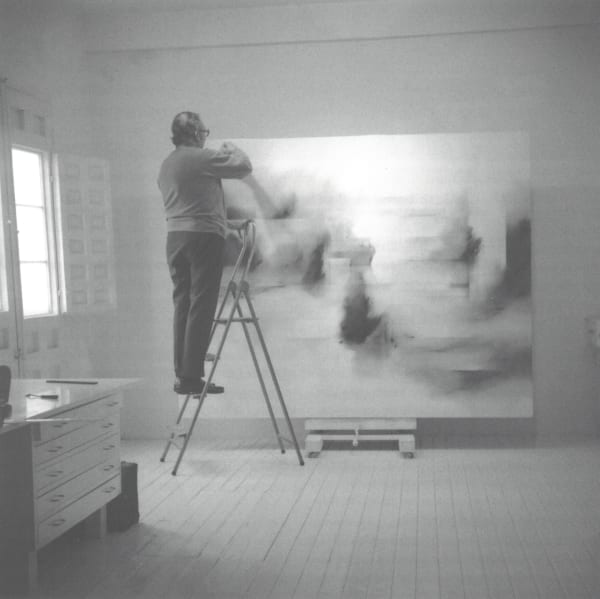Zóbel-Chillida. Croiscrossing Paths: BARCELONA
As artists, Zóbel and Chillida began to develop in a sort of isolation and in a problematic context. In the early 1950s Chillida conceived his first sculptures in plaster and stone, which would later result in works like Lurra 16 (Earth 16) (1978), Lurra G-326 (Earth G-326) (1995) and Lurra M-20 (Earth M-20) (1995), which conserve and rethink the corporeality and the folding of forms characteristic of those early figures. Meanwhile, Zóbel was concurrently moving between figuration and abstraction after witnessing the development of abstract expressionism.
Following his discovery of Rothko’s work in 1955, Zóbel reduced the content of his pictures to the essential, in compositional and thematic terms as well as in the use of colour. This would give rise to the Saetas (Arrows) paintings and to his first paintings with a limited colour palette, known under the generic title of Serie Negra (BlackSeries), of which some of the works on display, such as Aquelarre (Witches’ Sabbath) (1961) or Segovia II (1962), form part. Alfonso de la Torre notes that “In the Saetas Zóbel appears to concur with Chillida as to the heightened script-like stroke of black on the canvas, the two of them orienting their researches towards a certain mark-making that our consciousness attempts to comprehend, the rhythm of its unfolding. […] They can be understood as visual chords that waver between levity and gravity, in movement.” It was Zóbel’s definitive shift towards abstraction.
The Hispanic-Filipino artist evolved towards the study of light and the evocation of memory, both his own and that of the spectator. Zóbel himself explained that “essentially I’m speaking of light, of large forms and small forms, of what is far and what is near. Above all I think I speak of memories.”[1]The works of this second period are characterized by the reintroduction of colour—now symbolic—which constitutes the basis for the construction of the painting. In pictures like Canción protesta III (Protest Song III) (1968) we can see how the forms emanate from their coloration, becoming increasingly blurred until they blend into the background, in ever lighter and more neutral tones, which would eventually give rise to the so-called Serie Blanca (White Series), to which works like La plazoleta (The Little Square) (1975) pertain.
Light was also one of the principal themes in the works of Chillida. In his case his works are plays of matter and void in which light comes into being, assumes its importance and turns into a generator of spaces and volumes. As well as the Lurras, see such works in steel as Yunque de sueños XIX (Anvil of Dreams) (1998), Besarkada V (Embrace V) (1991) or the bronze Hierros de temblor III (Trembling Irons III) (1957). Without a doubt, the handling of this light and the delicacy of their creations means that the works of both artists have a high poetical value.
According to the director of the gallery, Jordi Mayoral, “not only is this exhibition an original dialogue between two artists of great relevance in postwar art, it is an encounter of ‘croiscrossing paths’ that render the project exceedingly attractive and exceptional.” In that sense, the curator concludes the meeting of the two artists in 1964 thanks to Zóbel’s wish to include the sculpture Abesti Gogorra IV (Rough Chant IV), one of Chillida’s seminal works, in the collection of art on show in the Museo de Arte Abstracto Español was a moment of “mutual admiration, the feeling of having known each other forever, friendship, a fondness for poetry, a way with words, a eulogizing of the East”.
A catalogue has been published for the show which as well as the curator’s introductory essay reproduces Zóbel’s letters to Chillida—also unpublished—together with interviews by the curator with to members of the artist’s families, Fernando Zóbel de Ayala y Miranda and Ignacio Chillida Belzunce, which allow us to delve into the relationship the artists maintained and also to comprehend their way of understanding and experiencing the making of art. By way of an epilogue, the curator Patrick D. Flores invites us to consider important aspects of the construction of Filipino modernity, the turn towards abstraction it involved and the way in which it alludes to the colonial past.
[1]PÉREZ-MADERO, Rafael; ZÓBEL DE AYALA, Fernando. Zóbel: La Serie Blanca. Madrid: Ediciones Rayuela, 1978, p. 35.
-

Letters from Fernando Zóbel to Eduardo Chillida
A collection of letters from Eduardo Zóbel to Eduardo Chillida dated between 1964-1979. Published in the exhibition catalogue "Zóbel-Chillida. Criscrossing paths" May 20, 2019Letter from Fernando Zóbel of 17 September 1964 in which he expresses his satisfaction with their meeting in Cuenca and gives more detail on the...Read more -

Words and ways about the Eulogy of the Horizon and other public sculptures (1990) | Fernando Huici
Fernando Huici interviews Eduardo Chillida. Published in the catalogue "Zóbel-Chillida. Criscrossing paths " on the occasion of the exhibition at Galeria Mayoral, Barcelona-Paris May 15, 2019FH [Fernando Huici]: In any case, from an immediate contemplation of your piece, the illusion is that of a very strict geometry. EC [Eduardo Chillida]:...Read more -

An interview with Ignacio Chillida Belzunce and Fernando Zóbel de Ayala y Miranda | Alfonso de la Torre
Alfonso de la Torre interviews Ignacio Chillida Belzunce, the son of Eduardo Chillida, and Fernando Zóbel de Ayala y Miranda. Text Published in the exhibition catalogue "Zóbel-Chillida. Criscrossing paths" May 14, 2019The image of the artist nowadays Alfonso de la Torre [AT] : When I consider certain artists who are no longer with us, hoping to...Read more -

International Conference on Sculpture (August 1988) | Eduardo Chillida
Text of the lecture given by Eduardo Chillida at Trinity College, Dublin on the occasion of the International Conference on Sculpture on August 1998. Text Published in the exhibition catalogue "Zóbel-Chillida. Criscrossing paths " May 13, 2019Limits are the real protagonists of space, just as the present, another limit, is the real protagonist of time. The concept of place implies dimension...Read more -

Conversations with Fernando Zóbel | Rafael Pérez-Madero
Rafael Pérez-Madero interviews Fernando Zóbel, 1978. Published in the catalogue "Zóbel-Chillida. Criscrossing paths " on the occasion of the exhibition at Galeria Mayoral, Barcelona-Paris May 7, 2019RPM [Rafael Pérez-Madero]: In going over the critical literature of those days I notice that you are often classified among the informalistas (a rough equivalent...Read more -

In painting (1975) | Fernando Zóbel
Article "En la pintura" by Fernando Zóbel about his work Text published in the exhibition catalogue "Zóbel-Chillida. Criscrossing paths " May 6, 2019I believe that each painter paints in relation to what surrounds him, and what has always surrounded me is the History of Art, works of...Read more -

Zóbel-Chillida, a Meeting | Alfonso de la Torre
Alfonso de la Torre, curator of the exhibition "Zóbel-Chillida. Criscrossing paths " at Galeria Mayoral Barcelona-Paris , talks about the connections of Zóbel and Chillida during his life April 29, 2019[Like crisscrossing paths, the lives of Zóbel and Chillida intersected in the mid-sixties. In the fifties, with the two of them a long way from...Read more












